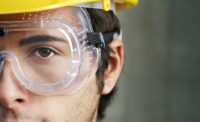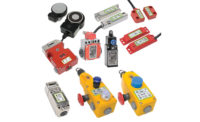The American National Standard for Occupational and Educational Eye and Face Protection (ANSI Z87.1-2010) defines what personal eye and face protection devices should be worn in specific situations to protect workers from impact, non-ionizing radiation such as radio waves, and liquid splash exposure. It does not include laser safety, which is covered under a different standard.
OSHA standards clearly define mandatory compliance and requirements for employers to follow with respect to eye and face protection. Following these requirements ensures protection against chemical, environmental, and radiological hazards or mechanical irritants.
The employer is responsible for completing a hazard assessment, see Standards – 29 CFR Part 1910.132(d). Based on the results, employees must be notified of the hazards, and select proper personal protective equipment (PPE). Employers must provide that equipment, and ensure it fits properly.
With PPE such as safety glasses, for example, the employer must train each employee on the when, what and how to wear this PPE, also called safety spectacles. Impact hazards and safety glasses’ limitations should also be explained.
Safety glasses are not unbreakable or impenetrable, and do not protect against severe impact hazards or other hazards such as heat, fluids, chemicals, dust and optical radiation. Additional machine guards, face shields, special lens filters and other safety equipment may be required in these situations.
While face shields are not the focus of this article, it’s important to note that if they are required due to a specific hazard, they must be used in combination with safety glasses or goggles. Face shields when worn alone do not provide sufficient protection.
Employers must provide all PPE needed for employees to work safely at no cost, unless the employee has lost or purposefully damaged the PPE. However, any person using or applying PPE is responsible for learning the safety requirements for their individual tasks and work environment.
To wear or not to wear
Safety eyewear protects one of the most sensitive areas of the human body, the eyes. For this reason alone, it should be worn in any and all instances where hazards may be present. The area where these hazards exist must be clearly posted, with warnings to wear safety glasses.
On the factory or shop floor, impact injuries can occur from adjacent operations or when walking down an aisleway due to flying or falling objects or sparks striking the eye. Be aware that multiple types of hazards may be present.
Safety glasses only provide limited protection against the most commonly encountered impact hazards. Typical safety glasses found in a factory protect against impacts to the eye from flying objects including large metal or wood chips, fragments, particles, sand and dirt. These are common hazards on the factory floor, especially around automated machines performing drilling, sawing, fastening, riveting, sanding, grinding and other operations.
In many facilities, a sign in the reception or entry area clearly states safety glasses are required on the shop floor. But in some smaller shops, this rule may be ignored and rarely enforced. In either case, it is difficult to wear a pair of safety glasses that cut into ears, are full of scratches, or are made larger than needed.
Cheap safety glasses with poorly manufactured lenses and blurry spots are a leading reason for workers to not wear eye protection. In the worst case, these glasses interfere with clear vision, creating a new safety hazard.
As noted, the employer must provide this PPE, and often the safety glasses’ rack is empty, or the glasses available are dirty or scratched. It’s easy to justify not wearing the safety glasses when they are “gooey,” dirty or worn out. Other reasons for not wearing safety glasses include lack of comfort and poor fit. Still, OSHA has requirements for comfort, fit and durability which must be followed. An employer can address these issues and requirements by providing improved PPE.
Proper care of PPE is important, as is the selection of quality eyewear. Safety glasses and other PPE must be in good condition, with inadequate equipment replaced, and care must be taken when purchasing all PPE.
Function and style
Modern safety eyewear combines OSHA-required eye protection with lightweight, comfortable fit, and stylish design. More frame and lens options are also available, with all meeting American National Standards Institute (ANSI) requirements for the industrial workplace.
Modern safety glasses typically have lightweight, shatterproof polycarbonate lenses with a scratch-protection coating. Various lens colors and tints are available along with polarized and anti-fog coatings. Smoke, mirror, and HD brown are some of the lens options for use in bright outdoor conditions. Gray lenses are suitable for general purpose indoor/outdoor use. Clear, yellow, orange and blue lenses enhance vision or reduce glare indoors under various lighting conditions.
Accessories such as microfiber bags, cloth zipper pouches and lanyards are available to protect the PPE, keeping it in top condition between daily use.
Conclusion
Safety glasses should be worn in areas marked as hazardous, and in areas where hazards may be temporarily present. Modern safety glasses have many options to provide required protection, with minimal inconvenience to the wearer. If treated with care, they will last for years, minimizing the expense of replacement.



